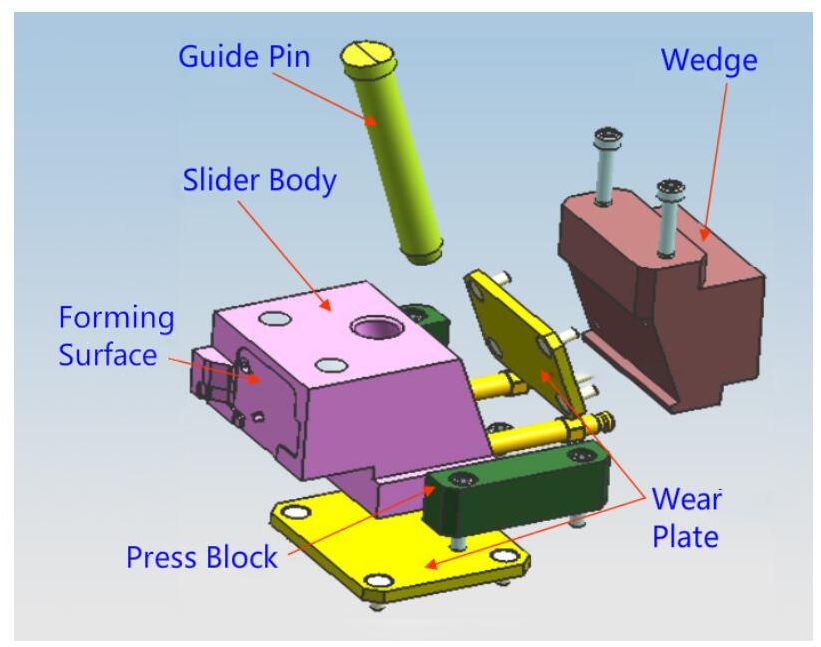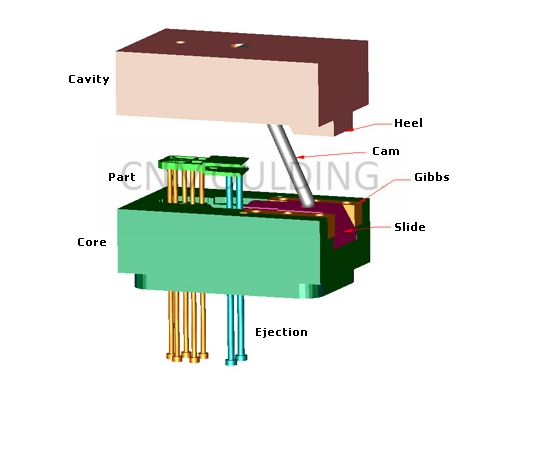Injection Mold Slider Design: Key Principles & Best Practices
Sliders (also called side-action cores or cam mechanisms) are essential mold components used to form undercuts or complex geometries that cannot be released by standard ejection systems. Here’s a comprehensive guide to slider design for injection molds:
1. When to Use Sliders?
Sliders are needed when:
- The part has external undercuts (e.g., side holes, hooks, threads).
- The part has internal undercuts (e.g., snap fits, internal grooves).
- Straight ejection would damage the part.
2. Slider Types & Mechanisms
| Type | Description | Application |
|---|---|---|
| Angled Pin Slider | Driven by a tapered pin during mold opening. | Simple side undercuts, low-cost. |
| Hydraulic Slider | Uses a hydraulic cylinder for controlled movement. | Complex undercuts, high precision. |
| Rack & Pinion | Gear-driven for smooth linear motion. | Long travel distances. |
| Lifter-Assisted | Combines a lifter + slider for deep undercuts. | Internal undercuts. |
3. Critical Design Parameters
(1) Slider Movement Calculation
- Travel Distance = Undercut Depth + (1~2mm safety margin).
- Angle Pin Angle (typically 15°–25°):
- Larger angle = Faster movement but higher friction.
- Smaller angle = Smoother but slower action.
(2) Guiding & Locking
- Wear Plates (hardened steel) reduce friction.
- Locking Blocks prevent slider deflection during injection.
(3) Cooling Considerations
- Avoid cooling lines near sliding surfaces to prevent warping.
- Use baffles/bubblers if cooling is necessary.
(4) Draft Angles
- Add 1°–3° draft on slider contact surfaces to ease release.
4. Step-by-Step Slider Design Process
- Identify Undercut Location
- Check part CAD for undercuts requiring side action.
- Choose Slider Type
- Angled pin for simple designs; hydraulic for complex motions.
- Calculate Travel & Angle
- Ensure full undercut clearance without interference.
- Design Slider & Core
- Use split cores if undercut is deep.
- Add Locking & Ejection
- Locking blocks + return pins for stability.
- Simulate Motion
- Check for collisions in mold-opening sequence.
5. Common Slider Defects & Solutions
| Issue | Cause | Solution |
|---|---|---|
| Slider Sticking | Poor lubrication/wear. | Use self-lubricating materials (e.g., bronze guides). |
| Part Damage | Insufficient travel/draft. | Increase slider stroke or draft angle. |
| Flash Formation | Worn locking surfaces. | Replace hardened lock blocks. |
6. Advanced Tips
- Micro-Sliders: For tiny undercuts (<2mm), use spring-loaded mini-sliders.
- Collapsible Cores: For threaded parts, use retractable cores.
- 3D-Printed Sliders: For prototypes, use metal 3D printing for complex geometries.
Conclusion
A well-designed slider ensures smooth demolding of complex parts while maintaining mold longevity. Prioritize:
✔ Precise travel calculation
✔ Robust locking/guiding
✔ Proper cooling & lubrication
For high-volume production, hydraulic sliders offer better control, while angled pin sliders are cost-effective for simpler molds.
Would you like a specific case study (e.g., automotive part slider design)?


In conclusion, the design of an injection mold slider is a critical factor in the success of any injection molding process. By carefully considering factors such as material choice, shape, mechanism, placement, and maintenance, it is possible to design a slider that functions correctly and produces high-quality parts. With careful planning and attention to detail, it is possible to create injection molds that deliver excellent results time and time again.
As a professional china injection mold company, we focus on precision mold making manufacturing
in china for the complicated slider.
没有评论:
发表评论